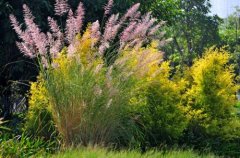What kind of plant is Grisha? what are its characteristics? Planting conditions and propagation time of Gleisa grass
One of the more common grasses in eastern North America is Gray's sedge. This plant has many colorful names, most of which refer to its plum blossom-shaped head. Gray's sedge is rarely cared for. As a landscape plant, it is excellent near ponds or water features. Continue to read Gray's sedge information to see if this plant is suitable for your garden.
Grey's Sedge Information Grassy plants provide ventilation elegance in many garden environments. The gray sedge (Carex grayi) is a native species with interesting star-shaped flower heads and arched erect sword-shaped leaves. What is Gray's sedge? The plant grows in wet to wet deciduous forests and grows along streams, swamps and swampy areas. The plant grows in more than half of eastern North America.
Gray's sedge is named after the famous American biologist Asagre. The plant is a perennial plant that can reach 2.5 feet (0.76 meters). The leaves are semievergreen and broad with a prominent midrib. The flowers are inconspicuous and last from spring to autumn. These fruits increase interest in the long season in winter. They are sharp clubs that can be used for fresh and dry arrangements. Most gardeners find that the characteristic of Grey's sedge surrounding water is the spectacular use of plants, especially in groups. It can also be used in containers, especially in dishwashing water gardens.
How to plant grey bolts this plant likes plenty of sunlight, but it can also perform well in some shady places. It requires USDA districts 4 through 9 to be rich in moist soil. The worse the soil drainage, the more plants like it and can even grow in marginal areas.
Sometimes, this sedge plant will seed on its own, but spring division is more likely to reproduce. When growing Gray's sedge, there are few insect pests or disease problems.
It looks very attractive when mixed with other marginal or aquatic plants, such as cattails or papyrus. Around the pond, it can create cover for birds and small animals. Seed heads are a high source of food for many aquatic and terrestrial birds.
Grey's Sedge Care Grey's sedge is a low maintenance factory. However, one thing it cannot tolerate is dry and dry soil. If growing in a container, keep the plant well watered.
This kind of sedge does not need to be fertilized regularly in wet, nutritious soil. The compost side skirt is enough to replenish nutrition.
If you do not want the plant to sow on its own, remove the seed before it turns brown. For the best appearance in cooler areas, cut leaves in late autumn or early spring. Plants are separated every three to five years in spring to prevent the center from dying out and to create more of these plants that are easy to grow.

- Prev

How to plant impatiens seeds? What is the most suitable temperature for impatiens planting?
Planting impatiens from seeds: balsam is moderately difficult to grow from seeds, but a small amount of TLC can produce satisfactory results. Impatiens need warm soil and light to sprout. A soil temperature of 75 degrees Fahrenheit (not room temperature) is perfect. If you are sending it
- Next

Plants can also send messages. how can they be transmitted? Experiments have proved that polypeptides can transmit plant defense messages.
Plants can also send messages! Chen Yong'an, a student from Taichung No. 1 Middle School, explored how the model organism "Arabian mustard" conveys defense messages through "salt stress", proving that the "winning peptide" between amino acid and protein can be used as a plant to transmit information, which is found to be helpful to farming.
Related
- A course of planting techniques and methods on how to grow carrots
- How to plant the latest tulips?
- Is it better to pick tea in the morning or in the afternoon? When is the best time for tea to be picked? what is the third or fifth tea?
- Launch Yuanxiao Happy combination Haocha + Tea Yuan healthy Taste
- Penghu Tourism "Fireworks 20 Parade with You"
- 2022 West Lake Happiness holds "Digital Revitalization Voucher" and draws iphone13 and laptop.
- Banqiao Fuzhou social houses are designed to change start-up combined with police elimination to create a safe and livable environment
- The convenient measure of "mechanical weeding" in Xinbei has been abused and the Agriculture Bureau has imposed heavy penalties on the illegal land consolidation.
- Changgeng University Joins Hands with Four Memory Factories to Rescue Memory Talent Shortage
- The list of Taiwan's top 100 MVP managers is listed by the Director-General of the Farmers' Association of Sanxia District.

